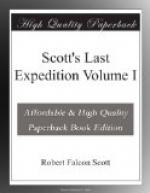After lunch four of us went back and dragged up the load. It taught us the nature of the surface more than many hours of pony leading!! The incident is deplorable and the blame widespread. I find W.W.’s load was much heavier than that of the other ponies.
I blame myself for not supervising these matters more effectively and for allowing W.W. to get so far behind.
We started off again after lunch, but when we had done two-thirds of a mile, W.W.’s condition made it advisable to halt. He has been given a hot feed, a large snow wall, and some extra sacking—the day promises to be quiet and warm for him, and one can only hope that these measures will put him right again. But the whole thing is very annoying.
Memo.—Arrangements for ponies.
1. Hot bran or oat mashes.
2. Clippers for breaking wires of bales.
3. Pickets for horses.
4. Lighter ponies to take 10 ft. sledges?
The surface is so crusty and friable that the question of snow-shoes again becomes of great importance.
All the sastrugi are from S.W. by S. to S.W. and all the wind that we have experienced in this region—there cannot be a doubt that the wind sweeps up the coast at all seasons.
A point has arisen as to the deposition. David [11] called the crusts seasonal. This must be wrong; they mark blizzards, but after each blizzard fresh crusts are formed only over the patchy heaps left by the blizzard. A blizzard seems to leave heaps which cover anything from one-sixth to one-third of the whole surface—such heaps presumably turn hollows into mounds with fresh hollows between—these are filled in turn by ensuing blizzards. If this is so, the only way to get at the seasonal deposition would be to average the heaps deposited and multiply this by the number of blizzards in the year.
Monday, February 15.—14 Camp. 7 miles 775 yards. The surface was wretched to-day, the two drawbacks of yesterday (the thin crusts which let the ponies through and the sandy heaps which hang on the runners) if anything exaggerated.
Bowers’ pony refused work at intervals for the first time. His hind legs sink very deep. Weary Willy is decidedly better. The Soldier takes a gloomy view of everything, but I’ve come to see that this is a characteristic of him. In spite of it he pays every attention to the weaker horses.
We had frequent halts on the march, but managed 4 miles before lunch and 3 1/2 after.
The temperature was -15 deg. at the lunch camp. It was cold sitting in the tent waiting for the ponies to rest. The thermometer is now -7 deg., but there is a bright sun and no wind, which makes the air feel quite comfortable: one’s socks and finnesko dry well. Our provision allowance is working out very well. In fact all is well with us except the condition of the ponies. The more I see of the matter the more certain I am that we must save all the ponies to get better value out of them next year. It would have been ridiculous to have worked some out this year as the Soldier wished. Even now I feel we went too far with the first three.




